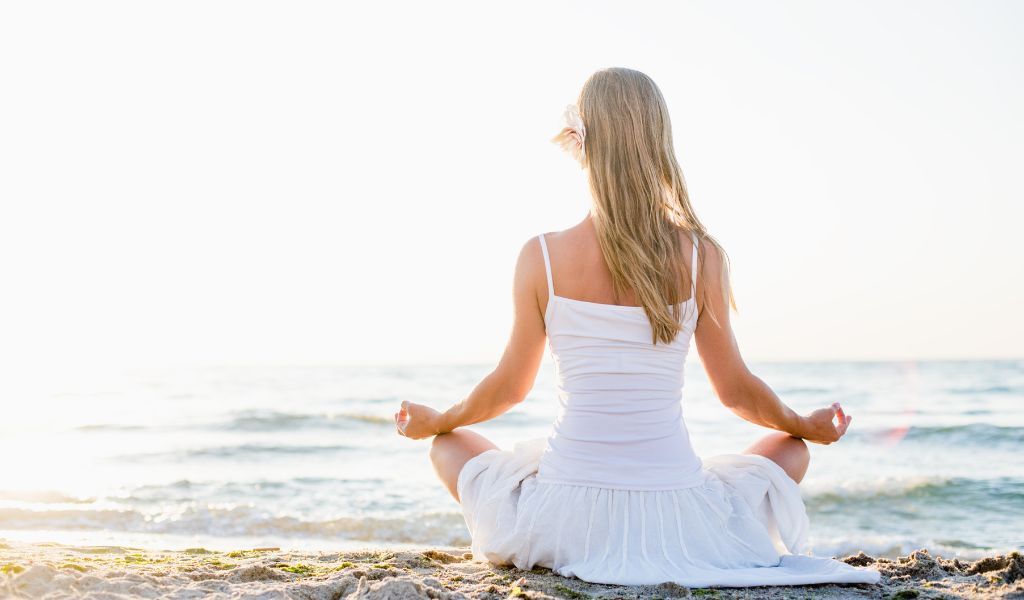The Best 4 Benefits of Meditation and How to Achieve Your Health Goals
Most people are particularly familiar with the mindfulness practices of meditation in the sense of connecting the body with the breath during a yoga session. In reality, the depths of meditation date back too long before society commercialized stretching. The act of sitting with one’s thoughts (or trying to quiet them) and focusing on your breath is so old that historians and experts are unable to pinpoint exactly where, why, and how this spiritual phenomenon came to be (A brief history of meditation, mindworks.org). It is guessed that early shamans and even ancient hunter-gatherers dipped their toes in the pool of meditation and passed along their information via storytelling and cave drawings. This spiritual practice has made its way from pre-civilization all the way to today’s society; let’s examine how.
Popularized by the religion of Buddhism, meditation quickly (and for good reason) gained traction in continents other than Asia. The Buddha, also known as Siddhartha Gautama, proclaimed that meditation, seeing things for what they truly are, and ethical conduct could take one all the way to enlightenment. Siddhartha Gautama once lived a lavish, comfortable lifestyle as a prince, but at the ripe age of 29, Gauatama witnessed old age, death, and illness through different older men that he met. It is with these images of an eventual, inevitable fate that he had decided to forgo his riches and devote himself to finding out more about the meaning of life beyond all the glamor. Siddhartha sought out mentors, such as yogis, and spent his time deep in nature, connecting with the mind. He even gave up eating so he could focus all of his attention and efforts on achieving a spiritual breakthrough. It is through this range of two completely different ways of living that Siddhartha unearthed his key to enlightenment and earned his title as “Buddha”, or “the enlightened one”. He believed that the middle path, neither extreme gluttony nor self-mortician, was the way to successfully achieve eternal peace and happiness. Individuals heard and digested what the Buddha had to offer. With this information, these initial followers spread the practice like wildfire.
The Silk Road, a trading route that has been around for ages and spreads from Asia to Europe, is largely responsible for how easily religion was shared. Though the route primarily dealt with the exchange of physical, tangible goods… ideas, customs, and traditions were inevitably shared along the way (The Silk Road, nationalgeographic.org). It’s important to note, however, that meditation began even before the Buddha, himself, came to be. One can find that The Vedas, an ancient text discovered in India, discussed rituals, hymns, yoga and meditation (National Library of Medicine, Meditation process and effects). This text, written in Sanskrit, went on to lay the foundation for Hinduism, which came roughly around 1700 B.C.E. (Hinduism and Buddhism- an introduction, smarthistory.org). As the art of quieting the mind made its way to new cities due to its travel along the Silk Road, meditation adapted to its surroundings. The actual act of meditation began to look different from what The Vedas described it as depending on where it was being practiced.
While nowadays meditation is an umbrella term for anything that can allow an individual to simply focus on the present moment, However, there are many different meditation techniques that range from sitting, standing and movement meditation as seen in Chi Gong, Tai Chi and Yoga. In addition, guided and visual meditations have become increasingly popular with the help of apps such as Youtube, Tik Tok and Headspace. Last but not least, there is also Vedic meditation. This meditation has a few specific instructions. Now referred to as “Transcendental Meditation”(yogapractice.com, Vedic Meditation), The Vedas called for individuals to repeat a mantra, silently, in one’s head. A mantra is a word or phrase used to evoke a response in the mind. Typically, a teacher would assign the chosen mantra to the student. The text also instructed that the meditators should practice twice a day, for twenty minutes each session (once in the morning and once in the evening, but not before bed as the practice can cause energy to begin flowing around the body). Today, meditation can be described as anything that puts a person’s mind in a “flow-like” state. Flow-like refers to a sensation that feels relaxed, yet focused(bbc.co.uk, Meditation). It can elicit a feeling of being “in the now”, and detached from any day to day concerns or anxieties. My idea of meditation and what gets me in that head space can appear very different from what you may choose to do to get into the same feeling. The good news is, no matter what way meditation is done, we can all reap the same bounty of health benefits that the practice offers.
Yes, you read that correctly. Meditation can be an incredibly useful tool for those looking to lose weight. Proven time and time again by different studies, scientists have proven that meditation in combination with a healthy diet and exercise can generate more weight and inches lost than proper nutrition and physical activity alone. In fact, in a systematic review done by the
We can’t touch on how meditation affects certain parts of the brain without discussing its impression on mental health. Depression and anxiety are two other health issues that a lot of the general public deals with in today’s society. In fact, anxiety is the most common mental illness among the US population, ringing in at 40 million people who suffer with the disease (Anxiety and Depression Association of America, Anxiety). Depression affects more than 17 million individuals in the United States, as well (Anxiety and Depression Association of America, Depression). If you are struggling with your mental wellbeing, meditation can be a cost-effective way to alleviate your symptoms and potentially rewire your brain to help mitigate the illness. College students are at high risk for feelings of stress and anxiety due to the nature and demand of attending school. In a study done by The American Journal of Pharmaceutical Medicine, they examined a group of about twenty students for a little over a month. The participants not in the controlled group underwent a six week program where they did yoga and practiced mindfulness meditation. The results showed a decrease in stress and anxiety levels and even suggested that practicing mindfulness for just once a week can still improve one’s mental state.
The art of meditation has evolved an incredible amount since its birth. What once was accomplished by just sitting quietly, allowing thoughts to pass by without judgment, can now be done in basically any way the individual sees fit. If your idea of relaxation and focus involves lifting weights, or singing in the car, or painting, or writing, or walking, or anything else your heart desires, that is great! Congratulate yourself on taking the time to indulge in a practice that will give back to your body and mind. It is safe to assume that our ancestors and predecessors would not care exactly how one achieves a meditative state, but they would simply be happy to see the ancient practice still alive to this day. There is a long line of people to thank for the transfer of meditation into modern times, so if you haven’t tried it yet, what is stopping you from starting a regular meditation practice? Here are some more ideas on how to tap into that blissfully aware mindset: – Yoga
– Drawing
– Playing an instrument
– Knitting or Crochet
– Reading
– Listening to the ocean
Have an awesOHM time trying out new ways to meditate and improve your health.
References:
Bai, Z., Chang, J., Chen, C., Li, P., Yang, K., & Chi, I. (2015, February 12). Investigating the effect of transcendental meditation on blood pressure: A systematic review and meta-analysis. Nature News. Retrieved June 16, 2022, from
BBC. (2009, November 24). Religions – buddhism: Meditation. BBC. Retrieved June 16, 2022, from https://www.bbc.co.uk/religion/religions/buddhism/customs/meditation_1.shtml
CDC. (2021, September 27). Facts about hypertension. Centers for Disease Control and Prevention. Retrieved June 16, 2022, from
https://www.cdc.gov/bloodpressure/facts.htm#:~:text=Nearly%20half%20of%20adults%20i n,are%20taking%20medication%20for%20hypertension.
Chételat, G., Lutz, A., Arenaza-Urquijo, E., Collette, F., Klimecki, O., & Marchant, N. (2018, June 22). Why could meditation practice help promote mental health and well-being in aging? – alzheimer’s research & therapy. BioMed Central. Retrieved June 16, 2022, from https://alzres.biomedcentral.com/articles/10.1186/s13195-018-0388-5
Depression: Anxiety and depression association of america, ADAA. Depression | Anxiety and Depression Association of America, ADAA. (n.d.). Retrieved June 16, 2022, from https://adaa.org/understanding-anxiety/depression
Facts & Statistics: Anxiety and Depression Association of America, ADAA. Facts & Statistics | Anxiety and Depression Association of America, ADAA. (n.d.). Retrieved June 16, 2022, from https://adaa.org/understanding-anxiety/facts-statistics
Departments of Psychology (K.L.O. (n.d.). Mindfulness and weight loss: A systematic review : Psychosomatic Medicine. LWW. Retrieved June 16, 2022, from
https://journals.lww.com/psychosomaticmedicine/Abstract/2015/01000/Mindfulness_and_ Weight_Loss__A_Systematic_Review.9.aspx
Lemay, V., Hoolahan, J., & Buchanan, A. (2019, June 1). Impact of a yoga and meditation intervention on students’ stress and Anxiety Levels. American Journal of Pharmaceutical Education. Retrieved June 16, 2022, from https://www.ajpe.org/content/83/5/7001.abstract
Mackenzie, A. (2021, May 27). Vedic meditation: A guide to how this ancient tradition works. YOGA PRACTICE. Retrieved June 16, 2022, from
National Geographic Society. (n.d.). The Silk Road. National Geographic Society. Retrieved June 16, 2022, from https://education.nationalgeographic.org/resource/silk-road
Press, C. (2020, February 11). Vedic meditation 101: Your guide to this ancient tradition. YogiApproved. Retrieved June 16, 2022, from
Rod-ari, D. M. (n.d.). Hinduism and Buddhism, an introduction. Smarthistory. Retrieved June 16, 2022, from https://smarthistory.org/hinduism-and-buddhism-an-introduction/
Ross, A. (2016, March 9). Meditation history: Religious practice to mainstream trend. Time. Retrieved June 16, 2022, from
Sharma, H. (2015). Meditation: Process and effects. Ayu. Retrieved June 16, 2022, from https://www.ncbi.nlm.nih.gov/pmc/articles/PMC4895748/
(2021, May 14). Where does meditation come from? meditation history & origins. Mindworks Meditation. Retrieved June 16, 2022, from
The post The Best 4 Benefits of Meditation and How to Achieve Your Health Goals first appeared on MO Marketplace and is written by MO Team




